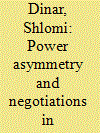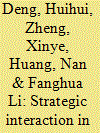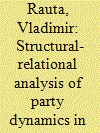| Srl | Item |
| 1 |
ID:
065289


|
|
|
| 2 |
ID:
019907


|
|
|
|
|
| Publication |
Summer 2001.
|
| Description |
93128
|
|
|
|
|
|
|
|
|
|
|
|
|
|
|
|
| 3 |
ID:
088932


|
|
|
|
|
| Publication |
2009.
|
| Summary/Abstract |
Realist thinkers traditionally argue that when the upstream state is the river basin's hegemon, cooperation is least likely to materialize. Conversely, when the downstream state is the basin's hegemon, cooperation is likely to ensue, yet the agreement is often imposed and shaped along the interests of the stronger party. Implied in both scenarios is that the otherwise weaker riparian, in aggregate power terms, is not in a position to achieve its aims and satisfy its needs in an optimal fashion. Its capabilities are inferior to those of its adversary. In effect, it has little alternative but to accept the desires of the stronger riparian. By considering a set of international water agreements and hydro-political contexts, this article challenges the realist conception of power in international river basins. Particularly, it demonstrates that otherwise weaker states may influence the hydro-political context and subsequent international agreements. Cooperation, in general, materializes when both states, but particularly the stronger state, realize that benefits can accrue from coordination and joint action. In other words, to harness the river in an efficient manner, cooperation must ensue and the downstream state's participation is important. Even when the benefits to cooperation are not clear, i.e. when the upstream riparian does not foresee immediate economic incentives to cooperation, coordination may still be attained through the manipulation of incentives (or strategic interaction).
|
|
|
|
|
|
|
|
|
|
|
|
|
|
|
|
| 4 |
ID:
114794


|
|
|
|
|
| Publication |
2012.
|
| Summary/Abstract |
In China, the responsibility of protecting the environment lies largely with local governments. Within the framework of spatial econometrics, we investigate empirically the consequence of such an institutional setting. Using city-level data for China, the present study finds that city governments behave strategically in making spending decisions regarding environmental protection. This paper finds that a city government appears to cut its own spending as a response to the rise in environmental protection spending by its neighbors. Hence, environmental protection tends to be underprovided. As a result, we suggest that centralizing the environmental protection responsibility to a higher level of government would be beneficial in terms of controlling pollution in China.
|
|
|
|
|
|
|
|
|
|
|
|
|
|
|
|
| 5 |
ID:
163100


|
|
|
|
|
| Summary/Abstract |
Proxy wars are still under-represented in conflict research and a key cause for this is the lack of conceptual and terminological care. This article seeks to demonstrate that minimising terminological diffusion increases overall analytical stability by maximising conceptual rigour. The argument opens with a discussion on the terminological ambivalence resulting from the haphazard employment of labels referencing the parties involved in proxy wars. Here, the article introduces an analytical framework with a two-fold aim: to reduce label heterogeneity, and to argue in favour of understanding proxy war dynamics as overlapping dyads between a Beneficiary, a Proxy, and a Target. This is then applied to the issues of defining and theorising party dynamics in proxy wars. It does so by providing a structural-relational analysis of the interactions between the above-mentioned parties based on strategic interaction. It presents a tentative explanation of the proxy relationship by correlating the Beneficiary’s goal towards the Target with the Proxy’s preference for the Beneficiary. In adding the goal-preference relational heuristic, the article advances the recent focus on strategic interaction with a novel variant to explanations based on interest, power, cost–benefit considerations or ideology.
|
|
|
|
|
|
|
|
|
|
|
|
|
|
|
|